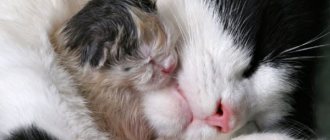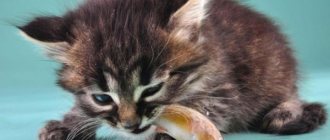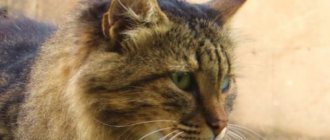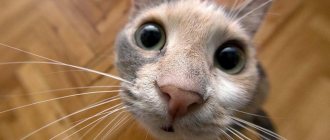A cat carries kittens in her teeth: 4 reasons
There is an opinion among breeders that the transfer of babies from place to place is most often due to the fact that:
- Household members show increased attention to kittens. A young mother begins to show concern if the owners and children constantly approach the nest, look at the newborn kittens, and try to touch them. The shelter begins to be perceived as unreliable, the animal reacts to excessive human curiosity as a threat to the cubs. Nature has laid down instincts for the preservation of offspring; the animal tries to find a secluded, hard-to-reach place to hide children.
- The place chosen by the owner for raising kittens does not correspond to its purpose. In the wild, the female chooses shelter in a warm, quiet place, hidden from the eyes of prying eyes; the size of the nest is also of great importance. For babies, the cat prepares a small shelter. Failure to comply with these parameters can lead to the fact that the young mother will begin to drag her cubs around the apartment, looking for a suitable place for them.
- Kittens reach a certain age. Animals that reach one and a half months of age begin to eat not only their mother’s milk, but solid food appears in their diet. Therefore, the young mother may begin to transfer her offspring to bowls filled with food. This is how she shows she cares.
- The birth was complicated by eclampsia. This condition is characterized by a lack of calcium. An animal weakened by childbirth and eclampsia begins to show increased aggression, becomes nervous, fearful, and irritable. Actions to transfer babies are a side effect during the development of the disease.
Be sure to read:
At what age is it better to adopt a kitten: when is it possible, why can’t you adopt it early, what are the dangers
Undesirable consequences
There are certain dangers in having a cat constantly traveling around the apartment with small kittens. When dragging the cubs, they may be injured. A cat can drop them from a height, and at this age a fall can be fatal.
When carrying the baby, the mother squeezes it quite tightly with her teeth, and when the kitten is already quite old, she drags it with drag. This situation can result in injury or death. Under no circumstances should you take kittens away from your pet while she is carrying them. The animal instinctively clenches its teeth tighter and can harm the baby.
Constantly carrying babies, the cat often forgets them. Without food and warmth, a helpless kitten may die.
Why does a pet hide kittens?
According to reports from owners of first-born cats, the mother often hides her offspring due to her inexperience. A young cat does not yet know what to do with babies who squeak pitifully. The frightened female begins to drag and hide the kittens.
The owner should properly organize the shelter (prepare a convenient box, calm the cat, protect the household from curiosity).
Another reason for hiding is the illness or poor health of one of the cubs. The owners observe the following picture: the cat drags the weakest kitten around the room, looking for an opportunity to accommodate it in the best possible way. Having found a place that is safe, from the animal’s point of view, the mother brings the others there in her teeth.
Reason for changing registration
There are pets who are overly concerned about their children. They move away a little from giving birth and begin to constantly drag their offspring, finding new habitats every day. Before you find out what the owner should do in such cases, it is worth familiarizing yourself with the reasons for this behavior of the mother:
- The mother is not satisfied with the place chosen by the owners. It may be too hot (the box is under the radiator) or, conversely, very cold; insufficiently protected; too crowded (for example, this is the kitchen, where there are always a lot of people). Also, an area of the house that is too bright may not suit the mother cat. In the latter case, she will drag her offspring into the closet, where it is darker.
- Mom's inexperience. We are talking about first-born cats. They still don’t understand why their babies squeak. Not knowing what to do, such mothers begin to drag their kittens to other places.
- Eclampsia. This is the most serious and dangerous reason for such actions by a new mother. The disease can occur within a month after birth. Its causes are a deficiency or excess of calcium in the body, metabolic disorders or poor nutrition during pregnancy. Eclampsia in females is manifested by nervousness, which turns into aggressiveness, and heavy breathing. A mother with this disease will constantly move her babies to other places. She can bite them. If you suspect eclampsia, it is important to immediately seek help from a cat doctor, otherwise the cat may even die.
- Breed specificity. Representatives of some breeds have a well-developed protective instinct. It manifests itself precisely in excessive guardianship over the offspring, in attempts to drag them into dark places inaccessible to the owners. This is what Singaporeans and Bengal cats do. In this way, they seem to throw predators off the scent and protect the cubs.
If a mother constantly drags her very young kittens around, then such actions can have serious consequences for them. For example, jumping from a height, jumping over the high side of a box, a mother can drop her baby. By holding a child tightly by the withers, a cat can injure him. That is why it is strictly forbidden to forcibly snatch kittens from their mother’s mouth. It also happens that a cat drags each cub to different places and forgets where exactly she hid it. This way the baby can die, especially if he is still blind.
What can happen when dragging babies
If a cat constantly drags babies in her teeth, looking for a more reliable place for a nest, the following dangers await the kittens:
- During the transfer process, the kitten may fall, damage limbs, and receive serious injuries.
- While dragging, the cat may damage its withers by biting too hard.
- While hiding the kitten, a young mother may forget where the next hiding place is. A weakened, sick baby will die without maternal care.
How to make a nest for kittens
If a cat behaves restlessly, constantly hides and is found in the most unexpected places, you should think about arranging a house for future kittens. If this process is left to chance, the female may give birth on a pile of bedding or in a clothes closet.
Advice from experienced cat lovers:
- A few days before giving birth, build 3 nests and place them in different, preferably dark, places in the apartment. When the cat chooses one of the proposed options, the rest must be removed.
- To arrange a cat's nest, take a box or basket of appropriate size. It is lined with soft fabric on the outside and inside, and material with a denser texture, such as baby diapers, is placed on the bottom. As an alternative, you can take an exhibition tent equipped with a door. If necessary, it can be closed and prevent children from dragging themselves around.
- In the room where the cat family will be, the optimal temperature should be set - not lower than 28°C. If necessary, use infrared lamps with a power of 250 W. At lower temperatures, babies may catch a cold. If a newborn's body temperature drops to 35°C, he or she develops aspiration pneumonia, which can be fatal.
The wardrobe is a favorite place for lambing among felines.
If you follow the recommendations listed and do not disturb the kittens, the cat will not drag the babies to a new place.
The birth and care of newborn kittens are dictated by the maternal instinct of the female. You should only interfere with this natural process if absolutely necessary. Any help should be unobtrusive and delicate, since no one can know better than a mother how to take care of babies.
What to do if your pet is carrying babies
Owners of young cats can observe the following situation: a pet that has lambed for the first time is dragging its cubs around. To avoid unpleasant consequences, the owner should take care of the pet in advance.
Algorithm of actions:
- Before giving birth, prepare a suitable place for the expectant mother to nurse. Observe your pet where exactly she feels most comfortable. Organize a nest in a place chosen by the cat.
- Agree in advance with household members that after lambing the animal will not be shown undue attention. A young mother should feel completely safe.
- Before giving birth, visit a veterinarian who will examine the pregnant woman and prescribe vitamins and dietary supplements to avoid postpartum eclampsia.
- Prepare in advance a convenient box or basket in which the cat can feed the kittens.
Be sure to read:
Sex barrier for cats: release forms, dosage, course of administration, indications and contraindications
Under no circumstances should you scold or punish a cat carrying kittens. You should not independently carry babies hidden by their mother. Nature has instilled in females the instinct to preserve offspring. Violent actions on the part of humans can lead to the fact that the pet will stop caring for the cubs.
What should an owner do when a cat carries kittens?
Even during the period of bearing offspring, the owner must ensure that the expectant mother is satisfied with the “maternity hospital” he has equipped. It would be better if it was a spacious box with low sides. It's called a nest. The place should be warm, without drafts, not too lit, quiet. The box should be ready about a week before the birth so that the cat can sniff everything and adapt to it. If a pregnant woman spends several nights in a nest prepared by the owner, this reduces the risk of subsequent dragging of offspring by the cat.
Never take kittens from their mother by force! Such actions can negatively affect the pet’s psyche. After all, after giving birth, she experiences stress. Just block access to places where the mother should not go with her kittens, for example, to the closet. If a nursing pet has chosen a secluded corner under the radiator, then help her make it more comfortable: put some bedding and block it with something.
If you suspect eclampsia, be sure to call a veterinarian at home. He will inject the cat with calcium gluconate, a sedative, and she will soon calm down.
Source
Cat instincts and behavior
The habits, behavior and habits of pets are largely dictated by natural instincts and skills. What is the reason and why does a cat drag kittens from one place to another?
There may be several reasons why a cat may drag its kittens:
- The cat has no experience in motherhood and is constantly looking for more suitable places when carrying kittens.
- The conditions created by the owner for the cat and kittens are not suitable for the living and raising of animals. The female tries to move the kittens to other places in the house that, in her opinion, are more suitable for them. It's warmer, quieter, more comfortable and dry there.
- If a cat carries kittens by the withers, this may be considered specific to her breed. For example, a representative of the Bengal cat breed carries a kitten in her teeth in order to protect and hide it from potential predators and enemies.
- The cat carries older kittens so that they are closer to food resources, where the cat itself is usually fed.
- The cat carries the kittens for fire and life safety purposes, so that nothing bad happens to them.
- A particular cat disease is eclampsia, which can occur during the first month after birth. The prerequisites for the occurrence of disease in an animal may be poor living conditions, lack of calcium, genetic disorders and changes in metabolism.
Surprisingly, the kitten, as soon as it gets into its mother’s teeth when she is carrying it, immediately calms down and becomes quiet. Apparently, the cub instinctively feels that the cat is trying to save and protect him, to help her cub.
Among the particularly severe symptoms of feline eclampsia, when a cat drags kittens in her teeth, may be a prolonged aggressive and nervous state of the animal, heavy and rapid breathing, tremors of the head and limbs. With eclampsia, a cat carries kittens several times in a row, continuously doing this. The disease is treated in a hospital setting under the supervision of an experienced veterinarian.
The best place for kittens
To prevent the cat from dragging the babies around the room after giving birth, you should think about the location of the family in advance. To do this, it is necessary to prepare 3-4 nests a few days before lambing, let the furry mother choose the most suitable one herself. They need to be installed in a quiet room with shade. Places can be placed in the corners of the room to make the cat feel protected. It is advisable that there are no other animals nearby, the room is quiet and calm. Sometimes the best option, especially in apartments with children, is a wardrobe.
In any case, the place where the cat can hide the kittens should be dry, warm, and safe. Only in this case can we hope that it will suit the caring mother, and she will not look for another and drag the cubs.
House for a cat with kittens
To build a cat's nest, a cardboard box of the appropriate size is suitable. It can be lined with fabric and baby disposable diapers can be placed on the bottom. An exhibition tent is also perfect. It can be closed, which will prevent kittens from being dragged around at night and accidents to the cubs.
When the cat rolls, it will choose a place for itself from the nests pre-arranged by the owner. After this, fallback options must be removed.
The birth of kittens, feeding, caring for helpless animals, their protection and care are the natural instincts of any domestic cat. It is necessary for a person to interfere with these natural processes only if, for some reason, the cat is not satisfied with external conditions. In this case, the animal needs to be helped unobtrusively and delicately. This will not only reassure the new mother, but will also save the lives of the babies.
How to properly pick up a cat by the scruff of the neck
However, in some situations it becomes necessary to grab the cat by the scruff of the neck . This will be required, for example, when performing hygienic procedures (trimming nails, combing, etc.) or at an appointment with a veterinarian. If you grab the scruff of the neck correctly, this will calm and limit the animal’s movements, but will not cause him discomfort or pain.
In emergency situations, for example, when rescuing the cat, you need to grab it by the scruff of the neck
This is done like this:
- The collar must be removed (if there is one), since, unlike the skin on the scruff of the neck, it does not stretch at all. A cat can be accidentally strangled.
- The pet is placed on a flat, stable surface (table or floor), from which it will be easier to pick it up.
- Place the palm on the back of the neck and grab the loose skin on the back of the neck, closer to the ears. You need to take as much skin as possible (feeling for a good fold).
- Carefully lift the cat, holding it by the scruff. A heavy specimen needs to be supported with a second hand.
- At the end of the procedure, the cat is returned to its place and only then the skin is released. You should stroke and praise the sufferer and treat her with a treat.
It is important to grab the cat by the scruff of the neck correctly
You should not pick up a sleeping or overly excited cat by the scruff of the neck, or when he is eating.











